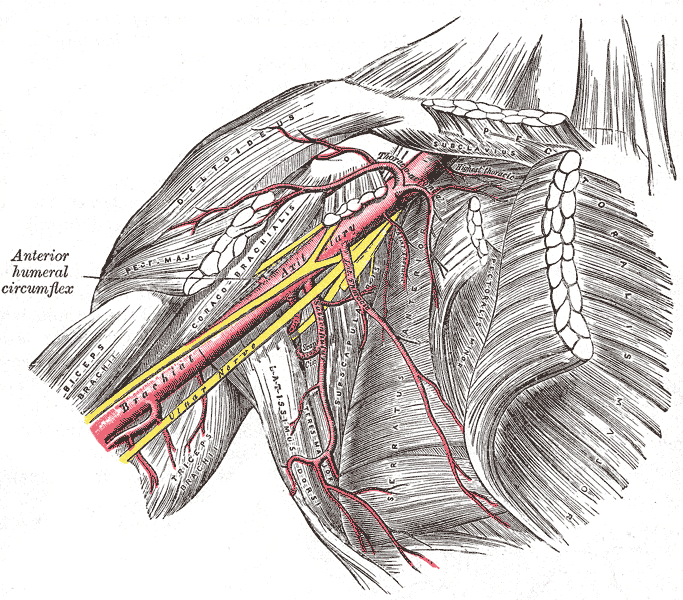Thoracoacromial artery
Jump to navigation
Jump to search
Editor-In-Chief: C. Michael Gibson, M.S., M.D. [1]
Overview
The thoracoacromial artery (acromiothoracic artery; thoracic axis) is a short trunk, which arises from the forepart of the axillary artery, its origin being generally overlapped by the upper edge of the Pectoralis minor.
Branches
Projecting forward to the upper border of the Pectoralis minor, it pierces the coracoclavicular fascia and divides into four branches—pectoral, acromial, clavicular, and deltoid.
| Branch | Description |
| Pectoral branch | Descends between the two Pectorales, and is distributed to them and to the mamma, anastomosing with the intercostal branches of the internal mammary and with the lateral thoracic. |
| Acromial branch | Runs lateralward over the coracoid process and under the Deltoideus, to which it gives branches; it then pierces that muscle and ends on the acromion in an arterial network formed by branches from the transverse scapular, thoracoacromial, and posterior humeral circumflex arteries. |
| Clavicular branch | Runs upward and medialward to the sternoclavicular joint, supplying this articulation, and the Subclavius. |
| Deltoid (humeral) branch | Often arising with the acromial, it crosses over the Pectoralis minor and passes in the same groove as the cephalic vein, between the Pectoralis major and Deltoideus, and gives branches to both muscles. |
Mnemonic
One mnemonic used to remember the four branches is "Cadavers Are Dead People".[1]
Additional images
-
The axillary artery and its branches.
References
External links
- Template:NormanAnatomy
- Template:SUNYAnatomyLabs - "Pectoral Region: Thoracoacromial Artery and its Branches"
- Template:SUNYAnatomyFigs - "The axillary artery and its major branches shown in relation to major landmarks."
- Template:EMedicineDictionary
